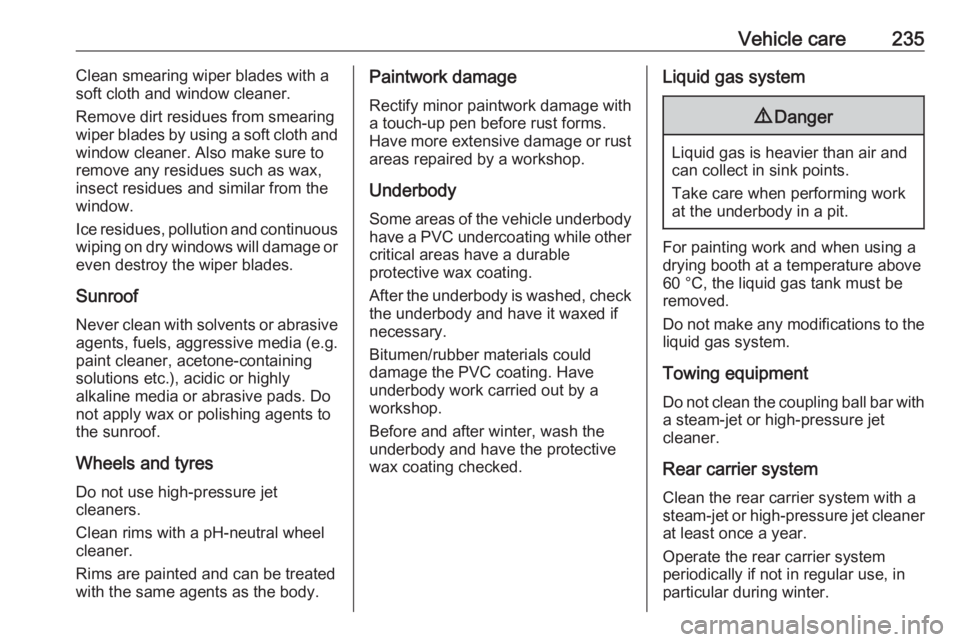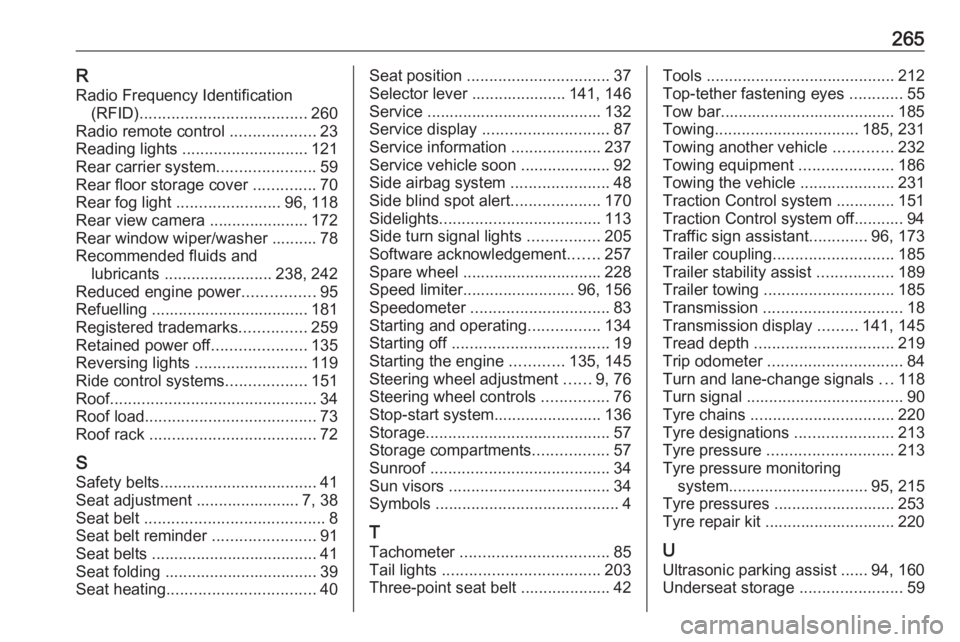tow OPEL CORSA E 2017.5 Manual user
[x] Cancel search | Manufacturer: OPEL, Model Year: 2017.5, Model line: CORSA E, Model: OPEL CORSA E 2017.5Pages: 269, PDF Size: 7.97 MB
Page 227 of 269

Vehicle care225This prevents sealant from
escaping. Stow tyre repair kit in
load compartment.
13. Remove any excess sealant using a cloth.
14. Take the label indicating maximum permitted speed from
the sealant bottle and affix in the
driver's field of view.
15. Continue driving immediately so that sealant is evenly distributedin the tyre. After driving approx.
10 km (but no more than ten
minutes), stop and check tyre
pressure. Screw compressor air
hose directly onto tyre valve and
compressor when doing this.
If tyre pressure is more than 1.3 bar , set it to the correct value.
Repeat the procedure until there
is no more loss of pressure.
If the tyre pressure has fallen
below 1.3 bar, the vehicle must
not be used. Seek the assistance
of a workshop.
16. Stow away tyre repair kit in load compartment.General information
Note
The driving characteristics of the
repaired tyre are severely affected, therefore have this tyre replaced.
If unusual noise is heard or the
compressor becomes hot, turn
compressor off for at least
30 minutes.
The built-in safety valve opens at a
pressure of seven bar.
Note the expiry date of the kit. After
this date its sealing capability is no
longer guaranteed. Pay attention to
storage information on sealant
bottle.
Replace the used sealant bottle. Dispose of the bottle as prescribed
by applicable laws.
The compressor and sealant can be
used from approx. -30 °C.
The adapters supplied can be used
to pump up other items e.g.
footballs, air mattresses, inflatable
dinghies etc. They are located on the underside of the compressor. To
remove, screw on compressor air hose and withdraw adapter.Wheel changing
Make the following preparations and
observe the following information:
● Park the vehicle on a level, firm and non-skid surface. The front
wheels must be in the straight- ahead position.
● Apply the parking brake and engage first gear, reverse gear or
P .
● Never change more than one wheel at once.
● Use the jack only to change wheels in case of puncture, not
for seasonal winter or summer
tyre change.
● The jack is maintenance-free.
● If the ground on which the vehicle
is standing is soft, a solid board
(max. 1 cm thick) should be
placed under the jack.
● Take heavy objects out of the vehicle before jacking up.
● No people or animals may be in the vehicle when it is jacked-up.
● Never crawl under a jacked-up vehicle.
Page 229 of 269

Vehicle care227may be used. The vehicle may be
damaged.
4. Set the jack to the necessary height. Position it directly below
the jacking point in a manner that
prevents it from slipping.
Attach jack handle and with the
jack correctly aligned rotate handle until wheel is clear of theground.
5. Unscrew the wheel bolts.
6. Change the wheel.
7. Screw on the wheel bolts.
8. Lower vehicle.
9. Install the wheel wrench ensuring that it locates securely and tighten
each bolt in a crosswise
sequence. Tightening torque is
110 Nm.
10. Align the valve hole in the wheel cover of the steel wheel with the
tyre valve before installing.
Install wheel bolt caps or centre
cap on alloy wheel.
11. Install vehicle jacking point cover.
12. Stow and secure the replaced wheel, the vehicle tools 3 212 and
the adapter for the locking wheel
bolts 3 57.
13. Check the tyre pressure of the installed tyre and the wheel bolt
torque as soon as possible.
Have the defective tyre renewed or repaired as soon as possible.
Jacking position for lifting platform
Page 230 of 269

228Vehicle careRear arm position of the lifting
platform located centrally under the
recess of the sill.
Front arm position of the lifting
platform at the underbody.
Spare wheel If mounting a spare wheel, which is
different from the other wheels, this
wheel might be classified as a
temporary spare wheel and the
corresponding speed limits apply,
even though no label indicates this.
Seek the assistance of a workshop to
check the applicable speed limit.
The spare wheel has a steel rim.
Caution
The use of a spare wheel that is smaller than the other wheels or in combination with winter tyres
could affect driveability. Have the defective tyre replaced as soon as
possible.
3-door/5-door hatchback
The spare wheel is located in the load
compartment beneath the floor
covering. It is secured with a wing nut.
Fitting a double load-bay floor in this
case in the upper position 3 70.
To remove, unscrew wing nut, lift
spare wheel, move to a vertical
position and remove from above.
When stowing the replaced wheel or
the temporary spare wheel back in
the spare wheel well, always secure
with the wing nut.Delivery van
Remove load floor.
The spare wheel is screwed down
together with the floor cover.
Unscrew wing nut and lift load cover.
Page 231 of 269

Vehicle care229
Remove spacer above the spare
wheel, lift the wheel, move to a
vertical position and remove from
above.
When stowing the replaced wheel or
the temporary spare wheel back in
the spare wheel well, always insert
the adapter and secure the load cover with the wing nut.
Depending on the defective replaced
wheel, the spacer can be omitted if
necessary, or the wheel can be bolted down without the floor cover.
Temporary spare wheelCaution
The use of the temporary spare
wheel could affect driveability.
Have the defective tyre renewed
or repaired as soon as possible.
Only mount one temporary spare
wheel. The permissible maximum
speed on the label on the temporary
spare wheel is only valid for the
factory-fitted tyre size.
If your vehicle gets a flat tyre on the
rear while towing another vehicle,
mount the temporary spare wheel in
the front and the full size tyre in the
rear.
Tyre chains 3 220.
Spare wheel with directional tyre If possible, fit directional tyres such
that they roll in the direction of travel.
The rolling direction is indicated by a
symbol (e.g. an arrow) on the
sidewall.
The following applies to tyres fitted
opposing the rolling direction:
● Driveability may be affected. Have the defective tyre renewed
or repaired as soon as possible
and fit it instead of the spare
wheel.
● Drive particularly carefully on wet
and snow-covered road
surfaces.
Page 233 of 269

Vehicle care2313. Connect the black lead to thenegative terminal of the booster
vehicle battery.
4. Connect the other end of the black
lead to a vehicle grounding point,
such as the engine block or an
engine mounting bolt. Connect as far away from the discharged
vehicle battery as possible,
however at least 60 cm.
Route the leads so that they cannot
catch on rotating parts in the engine
compartment.
To start the engine: 1. Start the engine of the vehicle providing the jump.
2. After five minutes, start the other engine. Start attempts should be
made for no longer than
15 seconds at an interval of one
minute.
3. Allow both engines to idle for approx. three minutes with the
leads connected.4. Switch on electrical consumers (e.g. headlights, heated rear
window) of the vehicle receiving
the jump start.
5. Reverse above sequence exactly when removing leads.Towing
Towing the vehicle
Insert a screwdriver in the slot at the
lower part of the cap. Release the cap
by carefully moving the screwdriver
downwards.
The towing eye is stowed with the
vehicle tools 3 212.
Page 234 of 269

232Vehicle care
Screw in the towing eye as far as it will
go until it stops in a horizontal
position.
Attach a tow rope – or better still a tow
rod – to the towing eye.
The towing eye must only be used for towing and not for recovering the
vehicle.
Switch on ignition to release steering
wheel lock and to permit operation of
brake lights, horn and windscreen
wiper.
Transmission in neutral.
Caution
Drive slowly. Do not drive jerkily.
Excessive tractive force can
damage the vehicle.
When the engine is not running,
considerably more force is needed to
brake and steer.
To prevent the entry of exhaust gases from the towing vehicle, switch on the
air recirculation and close the
windows.
Vehicles with automatic transmission: the vehicle must be towed facing
forwards, not faster than 80 km/h nor further than 100 km. In all other cases
and when the transmission is
defective, the front axle must be
raised off the ground.
Vehicles with manual transmission
automated: the vehicle must only be
towed facing forwards with the front axle raised off the ground.
Seek the assistance of a workshop. After towing, unscrew the towing eye.
Insert cap at the top and engage
downwards.
Towing another vehicle
Insert a screwdriver in the slot at the
lower bend of the cap. Release the
cap by carefully moving the
screwdriver downwards.
The towing eye is stowed with the
vehicle tools 3 212.
Page 235 of 269

Vehicle care233
Screw in the towing eye as far as it will
go until it stops in a horizontal
position.
The lashing eye at the rear
underneath the vehicle must never be used as a towing eye.
Attach a tow rope – or even better a
tow bar – to the towing eye.
The towing eye must only be used for
towing and not for recovering a
vehicle.
Caution
Drive slowly. Do not drive jerkily.
Excessive tractive force can
damage the vehicle.
After towing, unscrew the towing eye.
Insert cap at the top and engage
downwards.
Appearance care
Exterior care Locks
The locks are lubricated at the factory using a high quality lock cylinder
grease. Use a de-icing agent only
when absolutely necessary, as this
has a degreasing effect and impairs
lock function. After using a de-icing
agent, have the locks regreased by a workshop.
Washing
The paintwork of your vehicle is
exposed to environmental influences. Wash and wax your vehicle regularly.
When using automatic vehicle
washes, select a programme that
includes waxing. Restrictions for
filmed or matt painted body parts or
decor tapes, see "Polishing and
waxing".
Bird droppings, dead insects, resin,
pollen and the like should be cleaned
off immediately, as they contain
aggressive constituents which can
cause paint damage.
Page 237 of 269

Vehicle care235Clean smearing wiper blades with a
soft cloth and window cleaner.
Remove dirt residues from smearing wiper blades by using a soft cloth and
window cleaner. Also make sure to
remove any residues such as wax,
insect residues and similar from the
window.
Ice residues, pollution and continuous wiping on dry windows will damage or
even destroy the wiper blades.
Sunroof Never clean with solvents or abrasive
agents, fuels, aggressive media (e.g.
paint cleaner, acetone-containing solutions etc.), acidic or highly
alkaline media or abrasive pads. Do
not apply wax or polishing agents to
the sunroof.
Wheels and tyres Do not use high-pressure jet
cleaners.
Clean rims with a pH-neutral wheel
cleaner.
Rims are painted and can be treated
with the same agents as the body.Paintwork damage
Rectify minor paintwork damage with
a touch-up pen before rust forms.
Have more extensive damage or rust areas repaired by a workshop.
Underbody
Some areas of the vehicle underbody
have a PVC undercoating while other critical areas have a durable
protective wax coating.
After the underbody is washed, check
the underbody and have it waxed if
necessary.
Bitumen/rubber materials could
damage the PVC coating. Have
underbody work carried out by a
workshop.
Before and after winter, wash the
underbody and have the protective
wax coating checked.Liquid gas system9 Danger
Liquid gas is heavier than air and
can collect in sink points.
Take care when performing work
at the underbody in a pit.
For painting work and when using a
drying booth at a temperature above
60 °C, the liquid gas tank must be
removed.
Do not make any modifications to the
liquid gas system.
Towing equipment
Do not clean the coupling ball bar with a steam-jet or high-pressure jet
cleaner.
Rear carrier system Clean the rear carrier system with a
steam-jet or high-pressure jet cleaner
at least once a year.
Operate the rear carrier system
periodically if not in regular use, in
particular during winter.
Page 265 of 269

263Control indicators.......................... 88
Control of the vehicle .................134
Controls ........................................ 76
Convex shape .............................. 30
Coolant and antifreeze ...............238
Corner lighting ............................ 116
Cruise control ...................... 96, 154
Cupholders .................................. 57
Curtain airbag system .................. 49
D Danger, Warnings and Cautions ...4
Daytime running lights ...............116
Declaration of conformity ............255
Diesel fuel system bleeding .......198
Diesel particle filter ...............94, 140
Door open .................................... 96
Doors ............................................ 27
Driver assistance systems ..........154
Driver Information Centre .............97
Driving characteristics and towing tips .............................. 185
Driving hints ................................ 134
E Easy entry..................................... 39
Electric adjustment ......................30
Electrical system......................... 207
Electronic climate control system 126
Electronic driving programmes . ........................................ 143, 148Electronic Stability Control.......... 152
Electronic Stability Control and Traction Control system ............94
Electronic Stability Control off....... 94
End-of-life vehicle recovery .......192
Engine compartment fuse box ...208
Engine coolant ........................... 194
Engine coolant temperature gauge ....................................... 86
Engine data ............................... 245
Engine exhaust .......................... 140
Engine identification ...................241
Engine oil ................... 193, 238, 242
Engine oil pressure ......................95
Entry lighting .............................. 121
Event data recorders ..................259
Exit lighting ................................ 121
Exterior care .............................. 233
Exterior light ................................. 96
Exterior lighting ....................14, 113
Exterior mirrors ............................. 30
F
Fault ................................... 143, 148
First aid ......................................... 72
First aid kit ................................... 72
Fixed air vents ........................... 131
Flex-Fix system ............................ 59
Fog light ....................................... 96
Fog lights ................................... 202Folding mirrors ............................. 30
Following distance indication ......160
Forward collision alert................. 157
Front airbag system .....................47
Front fog lights ........................... 118
Front seats.................................... 37
Front storage ................................ 58
Front turn signal lights ...............203
Fuel............................................. 177
Fuel consumption - CO 2-
Emissions ............................... 184
Fuel for diesel engines ..............178
Fuel for liquid gas operation .......179
Fuel for petrol engines ...............177
Fuel gauge ................................... 85 Fuel selector ................................ 86
Fuses ......................................... 207
G Gauges ......................................... 83
Gear shifting ................................. 93
General information ...................185
Glovebox ..................................... 57
Graphic-Info-Display ...................102
H Halogen headlights ....................199
Hand brake ......................... 149, 150
Hazard warning flashers ............117
Headlight flash ........................... 115
Headlight range adjustment ......115
Page 267 of 269

265RRadio Frequency Identification (RFID) ..................................... 260
Radio remote control ...................23
Reading lights ............................ 121
Rear carrier system ......................59
Rear floor storage cover ..............70
Rear fog light ....................... 96, 118
Rear view camera ...................... 172
Rear window wiper/washer .......... 78
Recommended fluids and lubricants ........................ 238, 242
Reduced engine power ................95
Refuelling ................................... 181
Registered trademarks ...............259
Retained power off .....................135
Reversing lights .........................119
Ride control systems ..................151
Roof .............................................. 34
Roof load ...................................... 73
Roof rack ..................................... 72
S Safety belts ................................... 41
Seat adjustment ....................... 7, 38 Seat belt ........................................ 8
Seat belt reminder .......................91
Seat belts ..................................... 41 Seat folding .................................. 39
Seat heating ................................. 40Seat position ................................ 37
Selector lever ..................... 141, 146
Service ....................................... 132
Service display ............................ 87
Service information ....................237
Service vehicle soon .................... 92
Side airbag system ......................48
Side blind spot alert ....................170
Sidelights .................................... 113
Side turn signal lights ................205
Software acknowledgement .......257
Spare wheel ............................... 228
Speed limiter......................... 96, 156
Speedometer ............................... 83
Starting and operating ................134
Starting off ................................... 19
Starting the engine ............135, 145
Steering wheel adjustment ......9, 76
Steering wheel controls ...............76
Stop-start system........................ 136
Storage ......................................... 57
Storage compartments .................57
Sunroof ........................................ 34
Sun visors .................................... 34
Symbols ......................................... 4
T
Tachometer ................................. 85
Tail lights ................................... 203
Three-point seat belt .................... 42Tools .......................................... 212
Top-tether fastening eyes ............55
Tow bar....................................... 185
Towing ................................ 185, 231
Towing another vehicle .............232
Towing equipment .....................186
Towing the vehicle .....................231
Traction Control system ............. 151
Traction Control system off........... 94
Traffic sign assistant .............96, 173
Trailer coupling ........................... 185
Trailer stability assist .................189
Trailer towing ............................. 185
Transmission ............................... 18
Transmission display .........141, 145
Tread depth ............................... 219
Trip odometer .............................. 84
Turn and lane-change signals ...118
Turn signal ................................... 90
Tyre chains ................................ 220
Tyre designations ......................213
Tyre pressure ............................ 213
Tyre pressure monitoring system ............................... 95, 215
Tyre pressures ........................... 253
Tyre repair kit ............................. 220
U Ultrasonic parking assist ...... 94, 160
Underseat storage .......................59